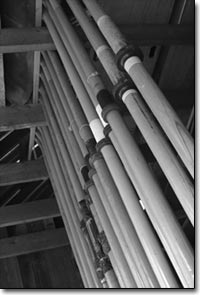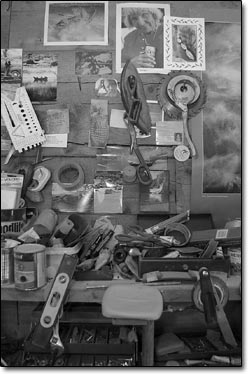|
Local boat builder works and lives a
labor of love
by Amy Maestas
 |
| Andy Hutchinson displays
his most recent creation, the shell of a new river
dory, inside his workshop Sunday afternoon. Hutchinson,
a Grand Canyon river guide, has been making the wooden
boats for nearly 20 years./Photo by Todd Newcomer. |
Andy Hutchinson prefers to float the massive, flesh-pounding
rapids of the famed Grand Canyon in high-grade plywood.
Never mind the 840/47-denier nylon, the Kevlar or the
fiberglass – those textiles that are ostensibly
the only ones that can withstand the unfortunate boat-bottom-to-snaggletooth-rock
meetings. For Hutchinson, the best trip in this beastly
canyon is layered, veneered wood, which, at first glance,
looks as if just sitting on it will snap it in half.
Not so. Hutchinson declares that the hard-hulled boat
sitting freely on the floor of his shop at the top of
Farmington Hill is brawny enough to withstand the toughest
of rapids in a sometimes unforgiving place. After all,
when Major John Wesley Powell forged the canyon in the
late 1800s, he and his accidental friends did so in nothing
but wood.
But Powell’s boats were unwieldy, keeled, cutwater
boats. What Hutchinson is building is a durable, graceful
dory – one that will glide smoothly down the magnificent
canyon and give its riders an unparalleled float. The
ride in a dory is so famous, so coveted, that this style
of boat is beginning to regain popularity.
For Hutchinson, this means all kinds of benefits; among
them is some income, since he is one of the few dory makers
in the West who custom-builds the boats
 |
| A row of ores hangs from the rafters
in Andy Hutchinson's barn./Photo by Todd Newcomer |
upon order. But more importantly, Hutchinson says, it
means reviving the spirits of pioneering river runners.
Only in the past 10 years have dories become a more sought-out
watercraft by river runners in search of a more “organic”
experience on the water.
“It’s kind of a retro thing going on,”
Hutchinson says. “It’s not like my phone is
ringing every day, but there has definitely been a surge.”
During the summer, Hutchinson works as a commercial guide
for Kanab-based Grand Canyon Expeditions. He almost exclusively
rows dories – whether on commercial or personal
trips. During the winter, he runs his business, High Desert
Boatworks.
Water fights and bikinis
Growing up in Salida, Hutchinson routinely drove by the
Arkansas River – the most popular whitewater river
in the country.
“In the summer I saw the guides out there having
water fights and the girls were in bikinis, and I thought,
‘Hey, I want to do that.’”
So he did. In the late 1970s, Hutchinson learned to paddle.
In 1982, he was invited on a Grand Canyon trip. It was
there that he spotted his first dory.
“I saw it, and I was smitten,” he recalls.
Two years later, he rowed his first dory on a winter
trip down the San Juan River. Only a few years later,
he built his first boat.
Hutchinson’s interest in river running pioneers
like Bus Hatch, Martin Litton and Norman Nevills fueled
his dory lovesickness. River historians credit Litton
for introducing whitewater dories to the industry and
the Grand Canyon. Hutchinson even credits Litton for successfully
fighting the Bureau of Reclamation against damming the
Grand Canyon after the agency had already done so with
Glen Canyon Dam by convincing the Bureau how valuable
the recreation industry was and how many people relied
on a free-flowing river.
“The dory saved the Grand Canyon,” Hutchinson
says.
Over the years, several veteran river runners have reworked
and refined whitewater dories. 4 As a baseline, Hutchinson
uses well-known boat builder Jerry Briggs’ designs
to build the 16-foot, 9-inches-long wooden boats that
typically have six hatches, passenger benches and hardwood
rails and trim. The finished product, Hutchinson says,
is a work of art.
“It’s definitely a labor of love. I feel
like it’s my piece of artwork, and I have a hard
time when one of them leaves my shop.”
Hand-making a Grand Canyon dory is time consuming. Each
one requires somewhere around 300 hours – or 2BD
months. This is partly why, Hutchinson says, there are
so few dory builders in the West (fellow Durangoan Derald
Stewart is also among this group). In between river time,
skiing and other outdoor pursuits, Hutchinson ends up
building only one a year. And he is fine with that. Hutchinson
is not keen on having a market flooded with mass-produced
dories. Nor is he solely interested in building dories
just for monetary gain.
For many years, he says, he undercharged customers simply
because he was new to the business and didn’t want
to exploit people. Even now, he winces at admitting he
actually makes a profit building boats.
“Yeah, I guess it’s that part of the river
runner in me,” he says.
 |
| A collection of tools
and river running paraphernalia litter Andy Hutchinson's
work bench./Photo by Todd Newcomer. |
The Sandra
In the 12 years Hutchinson has been a dory maker, he
estimates he’s built 10 from scratch. But he has
also undertaken at least 25 other dory projects, whether
it’s repair or helping others build. Each dory has
its challenges – and rewards. But none was as challenging
or rewarding as a project he took on in 2000.
Greg Reiff, Norman Nevills’ grandson, called Hutchinson
looking for help. In the late 1930s, Nevills created a
style of dory that was broader than the ones that Utah
trapper Nathaniel Galloway had been building for whitewater
boating. Nevills’ wider dory allowed him to cut
through the strong rapids with skill and safety. His style
of dories was so well liked that river runners used them
on the Colorado River for the next 30 years.
Reiff had found one of Nevills’ boats that he built
in 1947. Named the “Sandra” – after
his daughter (Reiff’s mother) – the dory was
sitting in a back yard, rotting away from age and exposure.
Nevills’ family wanted Hutchinson to restore it.
He agreed – solely because of the emotional rewards.
“It was very humbling,” Hutchinson recalls.
“I mean here’s this boat that was Norman’s,
and I got to bring it back to life.”
Because much of the boat had deteriorated, Hutchinson
had to extensively research how the boat was originally
built. He traveled to river museums, where some of Nevills’
Cataract Canyon boats were on display. Using measurements,
old photographs and a compilation of anecdotes (Nevills
died in a plane crash in 1949), he re-created an icon
of the West.
Ultimately, Hutchinson reconstructed the Sandra using
modern-day materials, such as epoxy and fiberglass. Nevills
originally used wood, screws and caulk. But because Reiff
wanted to float the boat on a river, they decided current
techniques were acceptable. After several months in a
Durango barn, Hutchinson relived history. He breathed
new life into a coveted dory and, to boot, was able to
meet Frank Wright, the Sandra’s main boatman when
he worked for Nevills. When Hutchinson sent the Sandra
on its way, he cried.
“I realized that through Frank, mama Sandra and
Cataract boat Sandra, old rivers and boats do talk,”
Hutchinson wrote in a memoir of the project.
Dory spark
Even without a story like the Sandra, Hutchinson still
believes each dory has its own spirit. When on the water,
he doesn’t often see the dories he builds. They
are far and wide. But if he does spot one of his handmade
crafts, he gets a kick out of it. He says it’s because
he knows how unique dories are to a river experience.
“Rafts are so care free – kind of Tom-Sawyer
like,” he explains. “And though dories are
less forgiving, they give you high performance.”
Yet, he still finds it difficult to explain that dory
“spark.” He can only quote the famous Litton:
“Those who have to ask will never know.”
|

